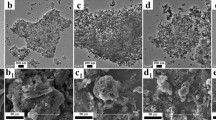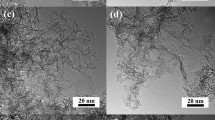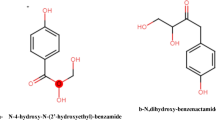Abstract
Reactive oxygen species enable efficient oxidative removal or detoxification of pollutants in water but traditional approaches for reactive oxygen species generation are chemically demanding, which limits their practical applications. Herein, we demonstrate a sustainable and chemical-free superoxide (O2•−) generation strategy by integrating rechargeable carbonaceous supercapacitors with redox-moiety-based O2 activation, which is distinct from production using traditional electrocatalysis. Highly porous carbonaceous geosupercapacitors were developed by pyrolysing cattle bones consisting of macromolecules interlinked with abundant minerals, followed by acid etching. Porous geosupercapacitors exhibit high capacitances and excellent electron-transfer efficiencies for O2 activation as a result of their abundant carbon defects and redox-active quinone moieties, thereby effectively transferring electrons to O2 to form O2•− radicals. Electrochemical analysis shows that the electron-transfer rate of the carbonaceous geosupercapacitor is orders of magnitude higher than that of traditional biochar, notably promoting electron transfer and O2 activation. This geosupercapacitor possesses excellent electron rechargeability and a stable capacitance, enabling sustainable O2•− production off-line. The utility of this green O2•− producing system is confirmed in different scenarios, such as stable performance in complex matrices, treating diverse redox-active pollutants and development of a portable chargeable device.
This is a preview of subscription content, access via your institution
Access options
Subscribe to this journal
Receive 12 digital issues and online access to articles
$99.00 per year
only $8.25 per issue
Buy this article
- Purchase on Springer Link
- Instant access to full article PDF
Prices may be subject to local taxes which are calculated during checkout






Similar content being viewed by others
Data availability
All data are presented in the article and its Supplementary Information. Source data are provided with this paper.
References
Wei, Y. et al. Fast and efficient removal of As(III) from water by CuFe2O4 with peroxymonosulfate: effects of oxidation and adsorption. Water Res. 150, 182–190 (2019).
Bello, M. M., Abdul Raman, A. A. & Asghar, A. A review on approaches for addressing the limitations of Fenton oxidation for recalcitrant wastewater treatment. Process. Saf. Environ. Prot. 126, 119–140 (2019).
Rahim Pouran, S., Abdul Raman, A. A. & Wan Daud, W. M. A. Review on the application of modified iron oxides as heterogeneous catalysts in Fenton reactions. J. Clean. Prod. 64, 24–35 (2014).
Winterbourn, C. C. Biological chemistry of superoxide radicals. ChemTexts 6, 7 (2020).
Bielski, B. H., Cabelli, D. E., Arudi, R. L. & Ross, A. B. Reactivity of HO2/O−2 radicals in aqueous solution. J. Phys. Chem. Ref. Data 14, 1041–1100 (1985).
Khiem, T. C. et al. Electron transfer-mediated enhancement of superoxide radical generation in Fenton-like process: key role of oxygen vacancy-regulated local electron density of cobalt sites. Appl. Catalysis B 343, 123490 (2024).
Hayyan, M., Hashim, M. A. & AlNashef, I. M. Superoxide ion: generation and chemical implications. Chem. Rev. 116, 3029–3085 (2016).
Li, H. et al. Persulfate adsorption and activation by carbon structure defects provided new insights into ofloxacin degradation by biochar. Sci. Total Environ. 806, 150968 (2022).
Qin, Y. et al. Persistent free radicals in carbon-based materials on transformation of refractory organic contaminants (ROCs) in water: a critical review. Water Res. 137, 130–143 (2018).
Ruan, X. et al. Formation, characteristics and applications of environmentally persistent free radicals in biochars: a review. Bioresour. Technol. 281, 457–468 (2019).
Wang, R.-Z. et al. Recent advances in biochar-based catalysts: properties, applications and mechanisms for pollution remediation. Chem. Eng. J. 371, 380–403 (2019).
Lian, F. & Xing, B. Black carbon (biochar) in water/soil environments: molecular structure, sorption, stability and potential risk. Environ. Sci. Technol. 51, 13517–13532 (2017).
Zhong, D. et al. pH dependence of arsenic oxidation by rice-husk-derived biochar: roles of redox-active moieties. Environ. Sci. Technol. 53, 9034–9044 (2019).
Yuan, J., Wen, Y., Dionysiou, D. D., Sharma, V. K. & Ma, X. Biochar as a novel carbon-negative electron source and mediator: electron exchange capacity (EEC) and environmentally persistent free radicals (EPFRs): a review. Chem. Eng. J. 429, 132313 (2022).
Klüpfel, L., Keiluweit, M., Kleber, M. & Sander, M. Redox properties of plant biomass-derived black carbon (biochar). Environ. Sci. Technol. 48, 5601–5611 (2014).
Sun, T. et al. Rapid electron transfer by the carbon matrix in natural pyrogenic carbon. Nat. Commun. 8, 14873 (2017).
Huang, Z. et al. Effects of anion carriers on capacitance and self‐discharge behaviors of zinc ion capacitors. Angew. Chem. 133, 1024–1034 (2021).
Lu, S. Y. et al. Chemically exfoliating biomass into a graphene‐like porous active carbon with rational pore structure, good conductivity and large surface area for high‐performance supercapacitors. Adv. Energy Mater. 8, 1702545 (2018).
Zhou, J. et al. Biomass-derived carbon materials for high-performance supercapacitors: current status and perspective. Electrochem. Energy Rev. 4, 219–248 (2021).
Zhu, J. & Mu, S. Defect engineering in carbon‐based electrocatalysts: insight into intrinsic carbon defects. Adv. Funct. Mater. 30, 2001097 (2020).
Singh, R., Singh, S., Parihar, P., Singh, V. P. & Prasad, S. M. Arsenic contamination, consequences and remediation techniques: a review. Ecotoxicol. Environ. Saf. 112, 247–270 (2015).
Zhu, S. et al. Catalytic removal of aqueous contaminants on N-doped graphitic biochars: inherent roles of adsorption and nonradical mechanisms. Environ. Sci. Technol. 52, 8649–8658 (2018).
Leng, L. et al. An overview on engineering the surface area and porosity of biochar. Sci. Total Environ. 763, 144204 (2021).
Chen, D. et al. Molten NaCl-induced MOF-derived carbon-polyhedron decorated carbon-nanosheet with high defects and high N-doping for boosting the removal of carbamazepine from water. Environ. Sci. Nano 7, 1205–1213 (2020).
Wang, Z. et al. Roles of N-vacancies over porous g-C3N4 microtubes during photocatalytic NOx removal. ACS Appl. Mater. Interfaces 11, 10651–10662 (2019).
Estrade-Szwarckopf, H. XPS photoemission in carbonaceous materials: a ‘defect’ peak beside the graphitic asymmetric peak. Carbon 42, 1713–1721 (2004).
Zhu, J. et al. Effects of intrinsic pentagon defects on electrochemical reactivity of carbon nanomaterials. Angew. Chem. Int. Ed. 58, 3859–3864 (2019).
Tao, L. et al. Bridging the surface charge and catalytic activity of a defective carbon electrocatalyst. Angew. Chem. 131, 1031–1036 (2019).
Sun, Y., Xu, D. & Wang, S. Self-assembly of biomass derivatives into multiple heteroatom-doped 3D-interconnected porous carbon for advanced supercapacitors. Carbon 199, 258–267 (2022).
Liu, K., Li, F., Zhao, X., Wang, G. & Fang, L. The overlooked role of carbonaceous supports in enhancing arsenite oxidation and removal by nZVI: surface area versus electrochemical property. Chem. Eng. J. 406, 126851 (2021).
Liu, K., Li, F., Pang, Y., Fang, L. & Hocking, R. Electron shuttle-induced oxidative transformation of arsenite on the surface of goethite and underlying mechanisms. J. Hazard. Mater. 425, 127780 (2022).
Ma, J., Zhou, H., Yan, S. & Song, W. Kinetics studies and mechanistic considerations on the reactions of superoxide radical ions with dissolved organic matter. Water Res. 149, 56–64 (2019).
Tian, R. et al. Electrochemical behaviors of biochar materials during pollutant removal in wastewater: a review. Chem. Eng. J. 425, 130585 (2021).
Dong, X., Ma, L. Q., Gress, J., Harris, W. & Li, Y. Enhanced Cr(VI) reduction and As(III) oxidation in ice phase: important role of dissolved organic matter from biochar. J. Hazard. Mater. 267, 62–70 (2014).
Meenakshi, S., Jancy Sophia, S. & Pandian, K. High surface graphene nanoflakes as sensitive sensing platform for simultaneous electrochemical detection of metronidazole and chloramphenicol. Mater. Sci. Eng. C 90, 407–419 (2018).
Sun, T. et al. Simultaneous quantification of electron transfer by carbon matrices and functional groups in pyrogenic carbon. Environ. Sci. Technol. 52, 8538–8547 (2018).
Xin, D., Saha, N., Reza, M. T., Hudson, J. & Chiu, P. C. Pyrolysis creates electron storage capacity of black carbon (biochar) from lignocellulosic biomass. ACS Sustain. Chem. Eng. 9, 6821–6831 (2021).
Kim, D.-h, Bokare, A. D., Koo, M. S. & Choi, W. Heterogeneous catalytic oxidation of As (III) on nonferrous metal oxides in the presence of H2O2. Environ. Sci. Technol. 49, 3506–3513 (2015).
Klüpfel, L., Piepenbrock, A., Kappler, A. & Sander, M. Humic substances as fully regenerable electron acceptors in recurrently anoxic environments. Nat. Geosci. 7, 195 (2014).
Kanematsu, M., Young, T. M., Fukushi, K., Green, P. G. & Darby, J. L. Arsenic(III, V) adsorption on a goethite-based adsorbent in the presence of major co-existing ions: modeling competitive adsorption consistent with spectroscopic and molecular evidence. Geochim. Cosmochim. Acta 106, 404–428 (2013).
Yu, G.-H. & Kuzyakov, Y. Fenton chemistry and reactive oxygen species in soil: abiotic mechanisms of biotic processes, controls and consequences for carbon and nutrient cycling. Earth Sci. Rev. 214, 103525 (2021).
Wang, Y., Ning, X., Liang, J., Wang, A. & Qu, J. Enhancing microbial superoxide generation and conversion to hydroxyl radicals for enhanced bioremediation using iron-binding ligands. J. Environ. Sci. 147, 597–606 (2025).
Nosaka, Y. & Nosaka, A. Y. Generation and detection of reactive oxygen species in photocatalysis. Chem. Rev. 117, 11302–11336 (2017).
Zhao, M. et al. Dual isolated bimetal single-atom catalysts for tumor ROS cycle and parallel catalytic therapy. Nano Today 44, 101493 (2022).
Liu, K. et al. A highly porous animal bone-derived char with a superiority of promoting nZVI for Cr(VI) sequestration in agricultural soils. J. Environ. Sci. 104, 27–39 (2021).
Ding, W. et al. Co-oxidation of As(III) and Fe(II) by oxygen through complexation between As(III) and Fe(II)/Fe(III) species. Water Res. 143, 599–607 (2018).
Hong, Z., Li, F., Borch, T., Shi, Q. & Fang, L. Incorporation of Cu into goethite stimulates oxygen activation by surface-bound Fe (II) for enhanced As (III) oxidative transformation. Environ. Sci. Technol. 57, 2162–2174 (2023).
Wang, X. et al. Ascorbate guided conversion of hydrogen peroxide to hydroxyl radical on goethite. Appl. Catalysis B 282, 119558 (2021).
Zhao, G. et al. Tide-triggered production of reactive oxygen species in coastal soils. Environ. Sci. Technol. 56, 11888–11896 (2022).
Fu, H. et al. Photochemistry of dissolved black carbon released from biochar: reactive oxygen species generation and phototransformation. Environ. Sci. Technol. 50, 1218–1226 (2016).
Acknowledgements
This work was financially supported by the National Natural Science Foundation of China (42321005 (F.L.); 42077301 (L.F.); 42030702 (F.L.); 42207040 (K.L.)), China Postdoctoral Science Foundation (2022M710835 (K.L.)), Guangdong Foundation for talents in scientific and technological innovation (2021TQ060193 (L.F.)), Guangdong Academy of Sciences’ Project (2019GDASYL-0102006 (L.F.)), GDAS Project of Science and Technology Development (2023GDASZH-2023010103 (K.L.); 2022GDASZH-2022010201-04 (L.F.)), Foreign Expert Program (G2023030041L (T.B.)).
Author information
Authors and Affiliations
Contributions
L.F. conceived and designed this project and wrote the original manuscript. K.L. performed experiments, materials preparation, data analysis and wrote the original manuscript. L.X. contributed to the conduct of the experiments. F.W. contributed to discussions of the results. T.B. and F.L. supervised the entire project and revised the manuscript.
Corresponding authors
Ethics declarations
Competing interests
The authors declare no competing interests.
Peer review
Peer review information
Nature Water thanks Baoshan Xing and the other, anonymous, reviewer(s) for their contribution to the peer review of this work.
Additional information
Publisher’s note Springer Nature remains neutral with regard to jurisdictional claims in published maps and institutional affiliations.
Supplementary information
Supplementary Information
Supplementary Text 1–4, Figs. 1–16 and Tables 1–4.
Source data
Source Data Fig. 1
Raw data; XRD, BET, Raman, EPR, XPS, CV, EAC/EDC and IR.
Source Data Fig. 2
Radical identification data.
Source Data Fig. 3
The As(III) oxidation by CGs data.
Source Data Fig. 4
Electrochemical analysis of CGs data.
Source Data Fig. 5
Cyclic performance of CGs data.
Source Data Fig. 6
Proof of concept data.
Rights and permissions
Springer Nature or its licensor (e.g. a society or other partner) holds exclusive rights to this article under a publishing agreement with the author(s) or other rightsholder(s); author self-archiving of the accepted manuscript version of this article is solely governed by the terms of such publishing agreement and applicable law.
About this article
Cite this article
Fang, L., Liu, K., Xu, L. et al. Rechargeable carbonaceous geosupercapacitor for sustainable superoxide generation and pollutant abatement. Nat Water 2, 485–495 (2024). https://doi.org/10.1038/s44221-024-00241-6
Received:
Accepted:
Published:
Issue Date:
DOI: https://doi.org/10.1038/s44221-024-00241-6



